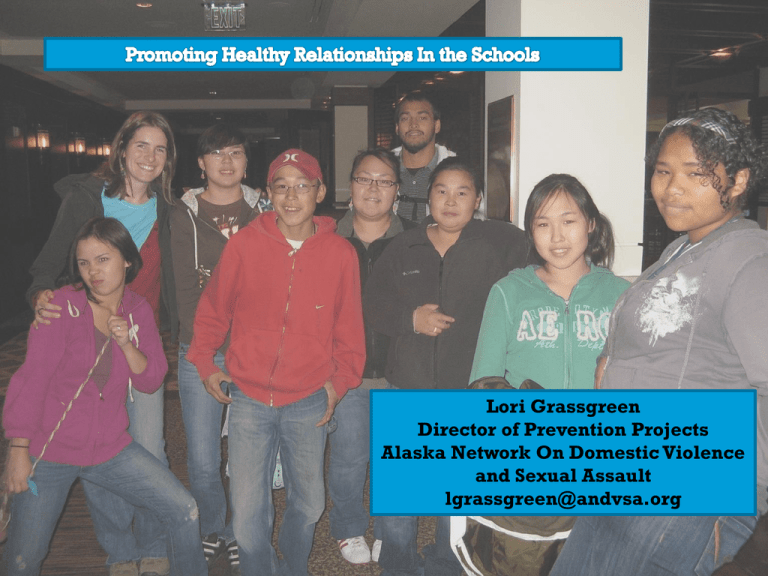
Lori Grassgreen
healthyrel.mov
Director of Prevention Projects
Alaska Network On Domestic Violence
and Sexual Assault
lgrassgreen@andvsa.org
Name
Community
Why this topic is important to your
students’ lives or important in your
classroom?
According
to Alaska YRBS data, by the
12th grade, over 16% of 12th graders
have been hit, slapped or physically hurt
by a boyfriend or girlfriend
There
is also some indication that these
numbers are significantly higher in
alternative school populations
Low
academic achievement
Witnessing violence
Heavy substance use
Communities or environments that have
low accountability
Social communities that promote rigid
gender roles and hypermasculinity
There
is increasing amount of research
that indicates there are protective factors
that reduce the risk for perpetrating
violence and protective factors for
identifying and participating in healthy
relationships.
When it comes to
relationships they are
interested and they are
listening.
SEARCH Institute Indicates that the higher the
number of assets in youth indicates lower
numbers of youth using violent behavior
Youth who are able to deflect substance use, use
refusal skills, and communicate effectively
School environments that are safe.
School and community environments that set
clear boundaries, policies, and consequences
Opportunities for youth to explore identity and
gender roles, especially with key influencers
School-based
classroom learning
School environments
Peer culture
Influencer reinforcement
Tools for analysis
Multi-lesson
curriculum
Culturally relevant
Developmentally appropriate
Addresses the triad of risk
Varied teaching methods
Multiple messengers
Includes community and is reinforced
outside of the classroom
The
Fourth R**
SAFE DATES *
Ending Violence X
Expect Respect * (more response oriented)
Respect Rx (pending)
Coaching boys to men (pending)
Men of Strength Clubs (pending)
Students in the Fourth R showed :
Higher levels of skills than their counterparts after the program.
more likely to use negotiation and delay skills in peer pressure scenarios
Less likely to yield to pressure
Teachers rated students who had participated in the Fourth R as having
better communication, skills, and more overall effectiveness than their peers.
At the end of grade 11, students in the Fourth R reported less dating
violence perpetration and a greater use of condoms.
Students in the Fourth R learned more, enjoyed health class more, and had
healthier attitudes about violence at the end of the program.
The relationship between child abuse and violent delinquency was much
weaker in Fourth R schools than in comparison schools.
Unit 1: Personal Safety and Injury Prevention (7 x 75-min. classroom sessions)
1. Focus on healthy relationships (myths/facts about teen relationships, relationship
rights & responsibilities)
2. Barriers to healthy relationships (active listening skills and types of violence/abuse)
3. Contributors to violence (group effects on violence, individual differences)
4. Conflict & conflict resolution (communication styles: passive, assertive, aggressive;
conflict scenarios)
5. Media violence (student presentations of examples of violence in the media)
6. Conflict resolution skills (rights and responsibilities when ending a relationship)
7. Action in the school and community
Unit 2: Healthy Growth and Sexuality (7 x 75-min. classroom sessions)
1. Focus on healthy sexuality (review of sexuality, myths clarified)
2. Sexuality in the media (media and peer pressure to have a partner/sex)
3. Responsible sexuality (communication with your partner, healthy relationships)
4. Preventing pregnancies and STIs
5. Assertiveness skills to deal with pressure in relationships (negotiation, delay & refusal
skills)
6. Sexuality: Responsibilities and consequences (sexual abuse, dating violence,
decision-making)
Unit 3: Deflecting Substance Use
•Classroom-based
tools
•Creating a peer
culture
• School
environment that
reinforce messages
•Involving key
influencers
•Reinforcing
messages outside of
school.
Challenges
Opportunities
Next Steps







